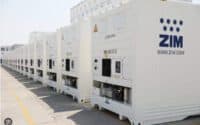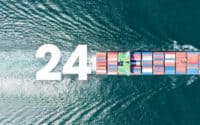3D Printing the Top 30 Replaceable Items Aboard Ships

In an era where technology continually reshapes the boundaries of possibility, the maritime industry stands on the cusp of a significant transformation. The advent of 3D printing aboard ships heralds a new age of efficiency, sustainability, and self-reliance. This revolutionary approach not only promises to mitigate the logistical nightmares of spare parts supply but also introduces an unparalleled adaptability in maintaining and enhancing vessel operations. From the engine room to the galley, and all the way to the crew’s living quarters, the ability to print a wide array of items on demand is a game-changer.
* Please send feedback/suggestions to editor @ shipuniverse.com
- Fittings and Flanges: Often used in piping systems, these components can be subject to wear and tear or damage. 3D printing them on board can significantly reduce repair times.
- Brackets and Mounts: Custom brackets and mounts for equipment or for securing items in place can be easily printed to fit specific needs or replace broken ones.
- Seals and Gaskets: These critical components can fail due to wear, leading to leaks or operational inefficiencies. Having the ability to print replacements on demand is invaluable.
- Valve Components: Parts like valve handles, stems, or even the valves themselves, especially for less critical applications, can be printed to match the exact specifications needed.
- Pulleys and Sheaves: Used in various systems onboard for lifting or moving items, these can wear out and are ideal candidates for 3D printing replacements.
- Electrical Housing and Covers: Protective casings for electrical components that are damaged can be quickly replaced with 3D-printed versions to ensure safety and compliance.
- Fasteners (Bolts, Nuts, Screws): While not suitable for high-strength applications, plastic fasteners can be used for temporary fixes or in non-critical areas.
- Custom Tools and Wrenches: Tools or wrenches for specific tasks or fittings unique to the ship can be designed and printed as needed.
- Cable Holders and Clips: Organizing cables and hoses is easier with custom-printed holders and clips that fit the ship’s specific layout and needs.
- Control Knobs and Switches: For non-critical applications, replacing damaged or lost knobs and switches for machinery controls can ensure continued operation without waiting for replacements.
- Instrument Panels and Enclosures: Customized panels for controls and displays, or protective enclosures for sensitive equipment, can be printed to fit specific configurations or replace damaged units.
- Pump Impellers: Smaller impellers for non-critical water or fuel pumps could be printed on board, allowing for quick replacements to maintain fluid operations.
- Door Handles and Lock Mechanisms: Simple mechanical components like door handles, hinges, and lock mechanisms can wear out or break, making them ideal candidates for 3D printing.
- Light Fixture Components: Custom or hard-to-find fittings for lighting systems, as well as protective casings, can be produced on demand.
- Storage Solutions: Custom shelving, containers, or organizers designed to fit specific spaces or to hold particular items securely can greatly enhance onboard storage efficiency.
- Ventilation Grilles and Filters: While filters themselves may not always be printable, the frames or housings for ventilation systems can be, as well as grilles with custom dimensions or designs.
- Hose and Pipe Connectors: Specific connectors or adapters that might not be readily available can be printed to join sections of hoses or pipes temporarily or permanently.
- Wear Plates and Linings: For areas subject to erosion or abrasion, custom wear plates or linings can be printed to protect surfaces or equipment, extending their service life.
- Signage and Labeling: Custom signs, labels, or instructional plates can be produced for clarity and safety, especially when specific warnings or instructions are needed in unique onboard locations.
- Bearing and Bushing Inserts: For less critical applications, bearing and bushing inserts can be printed to reduce friction and wear between moving parts, though careful consideration of the material’s properties is essential.
- Window Latch and Hinge Components: Parts for window mechanisms, especially in crew areas, can wear out or break, and having the capability to print replacements quickly ensures comfort and safety.
- Equipment Mounting Brackets: Custom brackets for mounting new equipment or for reconfiguring spaces can be designed and printed to suit specific requirements.
- Watertight Door Seals: While the material properties need to be carefully considered, 3D printing can offer temporary or permanent solutions for replacing seals on less critical watertight doors.
- Plumbing Fixtures: Simple fixtures like shower heads, faucet levers, or drain covers can be printed to replace damaged parts or upgrade facilities.
- Davit Components: Parts of the davit system used for launching lifeboats or rafts might not be under high load all the time and could be temporarily replaced with printed parts in an emergency.
- Galley Equipment Parts: Knobs, handles, or components for galley equipment like ovens, stoves, and refrigerators can be printed to keep these essential facilities operational.
- Deck Equipment Parts: Components for deck operations, such as caps, pins, or levers for winches, cranes, and hoists, could be printed to facilitate repairs or adjustments.
- Instrument Knobs and Dials: For non-critical instruments or systems, replacement knobs, dials, or buttons can be produced to maintain usability and control.
- Bollard and Fairlead Models: Scale models of ship’s bollards or fairleads could be printed for planning mooring arrangements or for training purposes.
- Custom Workstation Components: Elements designed to optimize workspaces, such as tool holders, monitor stands, or keyboard trays, tailored to the unique constraints of a ship.
Discover your Ideal 3d Printing Solution Today
he horizon for 3D printing within the maritime domain is as vast as the oceans themselves. By exploring these 30 items amenable to onboard production, we’ve merely skimmed the surface of what’s achievable. This innovative leap forward is not just about replacing parts; it’s about reimagining maritime logistics, enhancing crew self-sufficiency, and fostering a culture of innovation at sea. As materials science advances and printer capabilities expand, the list of printable items will undoubtedly grow, further embedding 3D printing as an indispensable tool in maritime operations.

Do you have a Maritime Product or Service that may be of interest to Shipowners? Tell us about it here!
Do you have feedback or insights? Please reach out to editor @ shipuniverse.com



